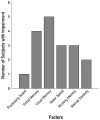White matter abnormalities are associated with overall cognitive status in blast-related mTBI
- PMID: 27704406
- PMCID: PMC5378671
- DOI: 10.1007/s11682-016-9593-7
White matter abnormalities are associated with overall cognitive status in blast-related mTBI
Abstract
Blast-related mild traumatic brain injury (mTBI) is a common injury of the Iraq and Afghanistan Wars. Research has suggested that blast-related mTBI is associated with chronic white matter abnormalities, which in turn are associated with impairment in neurocognitive function. However, findings are inconsistent as to which domains of cognition are affected by TBI-related white matter disruption. Recent evidence that white matter abnormalities associated with blast-related mTBI are spatially variable raises the possibility that the associated cognitive impairment is also heterogeneous. Thus, the goals of this study were to examine (1) whether mTBI-related white matter abnormalities are associated with overall cognitive status and (2) whether white matter abnormalities provide a mechanism by which mTBI influences cognition. Ninety-six Operation Enduring Freedom/Operation Iraqi Freedom (OEF/OEF) veterans were assigned to one of three groups: no-TBI, mTBI without loss of consciousness (LOC) (mTBI-LOC), and mTBI with LOC (mTBI + LOC). Participants were given a battery of neuropsychological tests that were selected for their sensitivity to mTBI. Results showed that number of white matter abnormalities was associated with the odds of having clinically significant cognitive impairment. A mediation analysis revealed that mTBI + LOC was indirectly associated with cognitive impairment through its effect on white matter integrity. These results suggest that cognitive difficulties in blast-related mTBI can be linked to injury-induced neural changes when taking into account the variability of injury as well as the heterogeneity in cognitive deficits across individuals.
Keywords: Cognitive impairment; DTI; Loss of consciousness; White matter integrity; mTBI.
Conflict of interest statement
Danielle R. Miller, Jasmeet P. Hayes, Ginette Lafleche, David H. Salat, and Mieke Verfaellie declare they have no conflict of interest.
Figures




References
-
- American Congress of Rehabilitation Medicine. Definition of mild traumatic brain injury. J Head Trauma Rehabil. 1993;8(3):86–87.
-
- Bazarian JJ, Donnelly K, Peterson DR, Warner GC, Zhu T, Zhong J. The relation between posttraumatic stress disorder and mild traumatic brain injury acquired during operations enduring freedom and iraqi freedom. J Head Trauma Rehabil. 2012;28(1):1–12. doi: 10.1097/HTR.0b013e318256d3d3. - DOI - PubMed
-
- Bigler ED. Neuroimaging Correlates of Functional Outcome. In: Zasler ND, Katz DI, Zafonte RD, editors. Brain Injury Medicine: Principles and Practice. New York, NY: Demos Medical Publishing; 2006.
-
- Blake DD, Weathers FW, Nagy LM, Kaloupek DG, Gusman FD, Charney DS, et al. The development of a Clinician-Administered PTSD Scale. J Trauma Stress. 1995;8(1):75–90. - PubMed
-
- Campbell TA, Nelson LAP, Lumpkin R, Yoash-Gantz R, Pickett T, McCormick CL. Neuropsychological measures of processing speed and executive functioning in combat veterans with PTSD, TBI, and comorbid TBI/PTSD. Psychiatric Annals. 2009;39(8):796–803.
Publication types
MeSH terms
Grants and funding
LinkOut - more resources
Full Text Sources
Other Literature Sources
Medical
Research Materials

